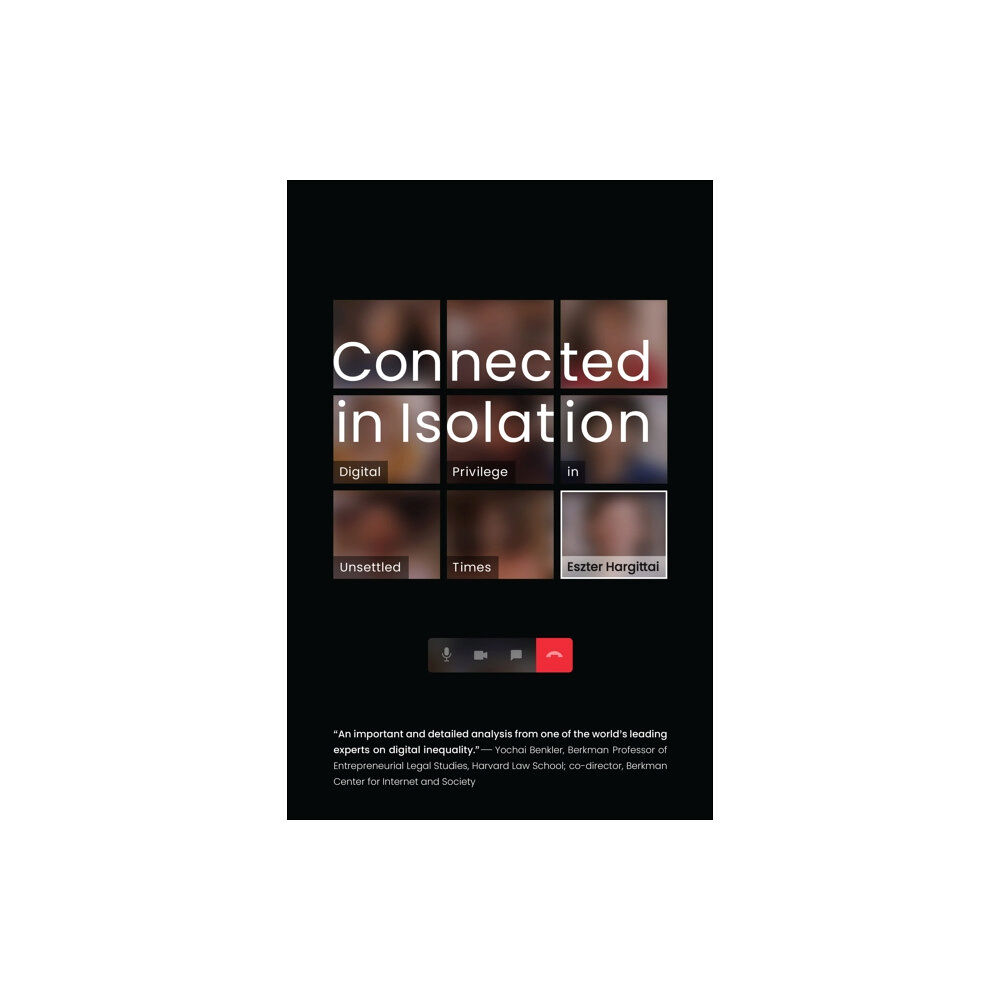- Hem
- Böcker
- Kurslitteratur
- Teknik, Industri & IT
- Connected in Isolation (häftad, eng)

Connected in Isolation (häftad, eng)
What life during lockdown reveals about digital inequality.
The vast majority of people in wealthy, highly connected, or digit...
The vast majority of people in wealthy, highly connected, or digit...
359 kr
405 kr
Bara 4 kvar
Skickas inom 2-3 vardagar
- Fri frakt
Fri frakt över 299:-
Snabb leverans
Alltid låga priser
Produktbeskrivning
What life during lockdown reveals about digital inequality.
The vast majority of people in wealthy, highly connected, or digitally privileged societies may have crossed the digital divide, but being online does not mean that everyone is equally connected—and digital inequality reflects experience both online and offIn Connected in Isolation Eszter Hargittai looks at how this digital disparity played out during the unprecedented isolation imposed in the early days of the coronavirus pandemic.
During initial COVID-19 lockdowns the Internet, for many, became a lifeline, as everything from family get-togethers to doctor’s visits moved onlineUsing survey data collected in April and May of 2020 in the United States, Italy, and Switzerland, Hargittai explores how people from varied backgrounds and differing skill levels were able to take advantage of digital media to find the crucial information they needed—to help loved ones, procure necessities, understand rules and risks.
Her study reveals the extent to which long-standing social and digital inequalities played a critical role in this move toward computer-mediated communication—and were often exacerbated in the process. However, Hargittai notes, context matters: her findings reveal that some populations traditionally disadvantaged with technology, such as older people, actually did better than others, in part because of the continuing importance of traditional media, television in particular.
The pandemic has permanently shifted how reliant we are upon online information, and the implications of Hargittai’s groundbreaking comparative research go far beyond the pandemicConnected in Isolation informs and expands our understanding of digital media, including how they might mitigate or worsen existing social disparities; whom they empower or disenfranchise; and how we can identify and expand the skills people bring to them.
The vast majority of people in wealthy, highly connected, or digitally privileged societies may have crossed the digital divide, but being online does not mean that everyone is equally connected—and digital inequality reflects experience both online and offIn Connected in Isolation Eszter Hargittai looks at how this digital disparity played out during the unprecedented isolation imposed in the early days of the coronavirus pandemic.
During initial COVID-19 lockdowns the Internet, for many, became a lifeline, as everything from family get-togethers to doctor’s visits moved onlineUsing survey data collected in April and May of 2020 in the United States, Italy, and Switzerland, Hargittai explores how people from varied backgrounds and differing skill levels were able to take advantage of digital media to find the crucial information they needed—to help loved ones, procure necessities, understand rules and risks.
Her study reveals the extent to which long-standing social and digital inequalities played a critical role in this move toward computer-mediated communication—and were often exacerbated in the process. However, Hargittai notes, context matters: her findings reveal that some populations traditionally disadvantaged with technology, such as older people, actually did better than others, in part because of the continuing importance of traditional media, television in particular.
The pandemic has permanently shifted how reliant we are upon online information, and the implications of Hargittai’s groundbreaking comparative research go far beyond the pandemicConnected in Isolation informs and expands our understanding of digital media, including how they might mitigate or worsen existing social disparities; whom they empower or disenfranchise; and how we can identify and expand the skills people bring to them.
| Format | Häftad |
| Omfång | 232 sidor |
| Språk | Engelska |
| Förlag | MIT Press Ltd |
| Utgivningsdatum | 2022-11-08 |
| ISBN | 9780262047371 |
Specifikation
Böcker
- Häftad, 232, Engelska, MIT Press Ltd, 2022-11-08, 9780262047371
Leverans
Vi erbjuder flera smidiga leveransalternativ beroende på ditt postnummer, såsom Budbee Box, Early Bird, Instabox och DB Schenker. Vid köp över 299 kr är leveransen kostnadsfri, annars tillkommer en fraktavgift från 29 kr. Välj det alternativ som passar dig bäst för en bekväm leverans.
Betalning
Du kan betala tryggt och enkelt via Avarda med flera alternativ: Swish för snabb betalning, kortbetalning med VISA eller MasterCard, faktura med 30 dagars betalningstid, eller konto för flexibel delbetalning.
Specifikation
Det finns tyvärr inga specifikationer att visa för denna produkt.
